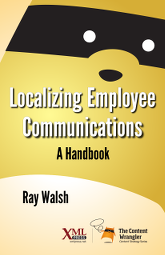Ray Walsh is the author of Localizing Employee Communications, which is part of the Content Wrangler Content Strategy book series. He is an American content consultant based in Prague. A one-time journalist, English language teacher, and later employee communications manager, he has broad experience in content creation for various industries in settings that include global multinationals based in the US and Europe.
Localizing Employee Communications draws on the insight of nearly 30 experts from a variety of communications disciplines to provide a practical guide to ending conventional communication practices that stand in the way of effectively reaching employees around the world.
In this interview, we asked Ray about his career, his book, and his thoughts on how the lessons he has learned in employee communications can apply to marketing and technical communication.
Thank you, Ray, for taking the time for this interview. Can you start out by telling us about your background and how you found your way into employee communications?
Traditionally, employee communications focuses on company news, so it’s always been a good fit for people with a background in journalism. My reporter phase goes back to my high school newspaper, so it’s been a long time. In fact, that school paper is a pretty good analogy to our work, both good and bad. Despite our sweat and tears, few of my classmates took the time to read it, and to this day, earning attention and growing audiences has turned out to be a career-long pursuit. When I began creating content for corporate communications, I soon learned that I preferred it to commercial journalism because I found it more collaborative. It’s still about getting a story, but it’s also about building consensus on what the full story is and how it should be told.
Please tell us about Localizing Employee Communications. Who it’s for, and what do you hope readers well get from the book?
The book is for anyone with a stake in improving the communication culture in their organizations. Startups and scaleups would do well to enable such a culture from the beginning, empowering people to communicate clearly and regularly on their own. In larger organizations, people driving transformation projects, or people who are frustrated that their internal constituents aren’t on the same page, can do much more than send an email or draft an article. Communication is often a second thought to business people, but the practices described in the book will help them take action themselves, get the right attention, and grow their influence. The book is also aimed at communication practitioners and directors, who often don’t give enough thought to how their work lands internationally.
Many of our communication departments are still operating as a traditional newsroom, where announcements are meant to trickle down to various locations. Outside the global headquarters, readership has always been smaller than we’d like, but in Europe, the complaints about the relevance of global messaging get a little bit louder. Despite the best of intentions, I continue to see ineffective practices at headquarters and from function heads that make the problem worse. With just a little effort to make content that’s adaptable for local needs, their work could have much more impact.
I originally drafted a pamphlet for my corporate colleagues to articulate communication needs from a local perspective. A good title for that pamphlet would have been The View from the Regions. But then I started talking to people in related fields, such as graphic design, language services and content strategy, about how they dealt with global complexities. In applying their perspective and my own experience with global content, I was able to scope out a more decentralized approach to employee communications. Looking at our organizations as ecosystems with a variety of channels, we can develop something more like content operations, something that enables local business units to communicate on their own. More and more, people expect a collaborative environment. Communicators should be looking for ways to help others create content that is accurate, in tune with what the company is saying globally, and more accessible and relevant to their people. It will help communication departments “do more with less,” a demand that never seems to go away.
Although your book is primarily addressed to internal communicators, it really has insights that apply to a much broader audience. How do the techniques used for internal communications apply to marketing communications in general?
At various times, regardless of profession, people occasionally need those outside their immediate work group to commit to an idea and take action. When they need that response, Localizing Employee Communications can help them get the attention of their intended audiences. Localizing Employee Communications shows how information flows through an organization – and how it doesn’t. The main reason that corporate content often falls flat is because it tries to be universal. One-size-fits-all messaging rarely works, and in order to resonate, high-level, abstract concepts need local examples. The same is true for department-level announcements, or broadcast messages from the company’s various functions. Businesses assume that keeping up with announcements is part of people’s job and that employees have a responsibility to seek them out. People don’t work like that, especially if they’re pressed for time. Employees are never a captive audience. Business people need to understand that to convince others, we have to find our more about our audiences and help them appreciate the importance of a message. In that way, employee communications is much like marketing. Once we have that buy in, we need to make sure that we clearly explain the actions they need to take. Those explanations need to be accurate and practical, and those aspects of employee communications are similar to technical documentation and user support. We need to be clear with ourselves about what a communication’s purpose is, and then apply the appropriate practices of marketing communications.
One of the important points you make is that the idea of information cascading from management down through lower-level managers to line-level employees is a myth. Why that is the case and what can be done to mitigate the problem?
A cascade is an analogy of information flowing to various groups of people. Theoretically, information starts with instructions from the top boss to share a piece of information as appropriate. This practice comes from a military mindset, where information is shared on a ‘need-to-know’ basis. But I would say that the concept of a cascade is rooted in our wider culture, because whether it’s a startup or a multinational with decades of history, leaders expect information to wind up with the right people. The problem is that information doesn’t flow naturally. There’s no gravitational force pushing information through like water.
To get an idea of how a cascade breaks down, you can think of another analogy: the Telephone Game. People receive a whispered message, and then whisper it to the next person. By the time it gets to the end of the line, the message is badly distorted. Another reason it breaks down is that only some people are natural sharers. They see the benefit to keeping their people informed, they do it well, and they probably even enjoy it. On the other hand, many, many managers are just plain lousy at communicating. They don’t study it at business school, and they forward emails with no comment or follow through. Some of them don’t even do that. Despite these shortcomings, many companies wanting to keep costs down rely on this mythical cascade to fill in the gaps that their formal channels leave open. That’s especially true in monolingual corporate headquarters who assume that local leaders will arrange for adaptations or translations when they’re needed. That faith is naive. The business units are not incentivized to communicate to employees, they don’t do it particularly well, and they’re more likely to be chasing sales or service goals that are more clearly tied to profitability. If we want information to flow, we need to do more to make that information easy to understand and use. For all that we’re spending on content, we can get much more reach if we make it adaptable. Localizing Employee Communications explores the options, so that regardless of your company’s size, structure or communication capabilities, you can make appropriate choices.
You interviewed a wide range of industry experts, in fields as varied as technical communication, marketing communication, localization, and cognitive neuroscience. Can you talk about how those interviews helped shape the book?
My early drafts focused on adapting employee content for language and culture. I’d had some direct experience with adapting content for different countries, but that had been a manual process limited by how many languages our team spoke. My first interviews for the book were with people in the localization industry, because I wanted to learn what else we could do so that people “downstream,” people whose languages we couldn’t support, could take our content and more easily adapt it if they chose to. Those lessons are an important part of the book, but there are other kinds of adaptations that need to be made by the local business unit, and we need to accommodate them as well.
My interviews, many of which were arranged by XML Press, showed me that there are related fields in content creation that have thought through the questions related to re-use, re-work, accuracy and updating, much more then we in employee communications have. The book takes those findings and outlines how our internal content creation can be part of an operation, something that saves others’ time and reduces error, and them gives some breathing room so that relevance and appeal can be shaped locally.
Many books on localization focus on the role of those in the main office, who are providing material to international locations. Your book gives an equal focus on the people working in the field and receiving that information. Why do you think that’s so important, and what can people in the main office learn from employees in the field?
One of people’s most common complaints about their employer is how poor communications is. But that’s ambiguous. Do they mean they don’t like the intranet’s functionality, or the articles they find there? Or are they thinking of a job that was recently filled and they didn’t know about it in time to apply? It may be all of those, and the traditional approach to internal communications–a central newsroom that cascades–has built an organizational culture that fails on both ends. Messaging from corporate HQ is out of touch because it’s impossible to produce something that’s meaningful to all. Meanwhile, local leadership fail to grasp that they have a responsibility to communicate and provide context. The centralized, top-down approach to communications has bred passivity where local business units wait for the perfect, fully formed campaign to be delivered to them. As it stands, we get simplistic, happy-clappy news from headquarters, and in response, locally, silent eye rolls. Changing this sad state for the better is going to require people throughout the organization taking a more active role in communications. Full and meaningful context can be provided only locally, and headquarters needs to understand how to leave room for that context. In the business units, people need to understand that making messages perfect is going to require much more from them. I’m convinced that the more decentralized processes described in the book can help get us there.
Throughout the book, you emphasize “co-creation.” Can you describe what that is and why it is so important?
In researching language services, I learned that language adaptation is a spectrum. On one end you start with English-only (where audiences get only one version), then direct translation (where an original gets translated word-for-word, probably into just a few of the organization’s biggest language groups), localization (where concepts are more thoroughly adapted to specific cultures), and finally, co-creation. Co-creation is where dispersed teams create content in parallel to each other. That content may have similarities, but each final product is more likely a unique creative work that will be more appealing to a specific audience. Co-creation is more often associated with marketing or advertising campaigns, but in fact, large global organizations often have this full range of language adaptations going on internally, whether they realize it or not. That is, most business units leave the corporate content as is, but there are always others that translate or adapt corporate content, while the largest and autonomously minded business units create unique content on their own.
As I write in the book, localization and co-creation are likely to have more powerful outcomes, but they’re not for everybody. Only a handful of business units have the means or incentive to take on those greater responsibilities. When they do though, they start taking ownership for the process from start to finish, and they track results. It gives them a chance to clarify abstractions, to get specific, to connect people’s day-to-day with larger strategies. People crave this kind of connection with their employer. They want to feel that messaging comes from a person they might know, rather than some distant machine. Co-creation may be largely aspirational, but it has the potential to fix a range of problems.
Anything else you’d like to add? Questions I forgot to ask, advice for writers, and more.
The main assertion of the book is that we in employee communications need help. We need other parts of the business to recognize their stake in communicating well, and we need them to co-operate with us to create and deploy messaging in all of our channels. But different parts of the business have different capabilities and needs. A core part of the book looks at this spectrum of adaptation–from “English only” all the way to co-creation–as an overall maturity model for internal communications. That is, which parts of your organization depend on global comms output, and which parts want to take on greater communications responsibility? Knowing what local businesses can and want to do will help the comms team plan their output and levels of support.
Generally, I would say that once a business unit starts adapting content, there will be a long-term evolution toward co-creation; however, some may go another direction. Maybe a business unit starts to outsource its manufacturing, and all of a sudden all of its employees are now desk-based engineers. In that case, they may choose to cease localization and use English-only, global content. There will be a spectrum of comms maturity across the organization, and it will always be in flux. The corporate office should know each unit’s maturity level (e.g., can they edit video?) so that they can plan for the right skills, resources and training. On the local level, I’d advise communicators and leaders to start asking more from the corporate comms team. Demand full briefings from them on the purpose, audience, outcomes, and measures for success for global compaigns. If your needs or aspirations are changing, start talking about it with them. Improvement is going to require partnership. No matter where you are in the company, Localizing Employee Communications shows you how to manage that partnership, what questions to ask, and what long-term practices to plan for.




